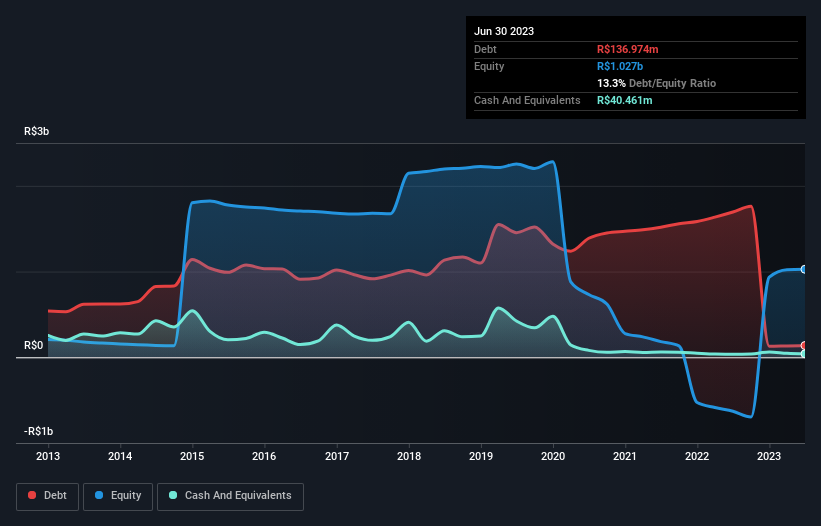We Think Veste Estilo (BVMF:VSTE3) Is Taking Some Risk With Its Debt
The external fund manager backed by Berkshire Hathaway's Charlie Munger, Li Lu, makes no bones about it when he says 'The biggest investment risk is not the volatility of prices, but whether you will suffer a permanent loss of capital.' It's only natural to consider a company's balance sheet when you examine how risky it is, since debt is often involved when a business collapses. Importantly, Veste S.A. Estilo (BVMF:VSTE3) does carry debt. But the real question is whether this debt is making the company risky.
When Is Debt Dangerous?
Debt assists a business until the business has trouble paying it off, either with new capital or with free cash flow. Ultimately, if the company can't fulfill its legal obligations to repay debt, shareholders could walk away with nothing. However, a more usual (but still expensive) situation is where a company must dilute shareholders at a cheap share price simply to get debt under control. Of course, plenty of companies use debt to fund growth, without any negative consequences. When we think about a company's use of debt, we first look at cash and debt together.
See our latest analysis for Veste Estilo
What Is Veste Estilo's Net Debt?
You can click the graphic below for the historical numbers, but it shows that Veste Estilo had R$137.0m of debt in June 2023, down from R$1.69b, one year before. However, because it has a cash reserve of R$40.5m, its net debt is less, at about R$96.5m.

How Healthy Is Veste Estilo's Balance Sheet?
We can see from the most recent balance sheet that Veste Estilo had liabilities of R$350.8m falling due within a year, and liabilities of R$290.9m due beyond that. Offsetting this, it had R$40.5m in cash and R$176.3m in receivables that were due within 12 months. So it has liabilities totalling R$424.9m more than its cash and near-term receivables, combined.
While this might seem like a lot, it is not so bad since Veste Estilo has a market capitalization of R$1.57b, and so it could probably strengthen its balance sheet by raising capital if it needed to. However, it is still worthwhile taking a close look at its ability to pay off debt.
We measure a company's debt load relative to its earnings power by looking at its net debt divided by its earnings before interest, tax, depreciation, and amortization (EBITDA) and by calculating how easily its earnings before interest and tax (EBIT) cover its interest expense (interest cover). Thus we consider debt relative to earnings both with and without depreciation and amortization expenses.
Given net debt is only 0.34 times EBITDA, it is initially surprising to see that Veste Estilo's EBIT has low interest coverage of 1.8 times. So while we're not necessarily alarmed we think that its debt is far from trivial. Notably, Veste Estilo made a loss at the EBIT level, last year, but improved that to positive EBIT of R$240m in the last twelve months. When analysing debt levels, the balance sheet is the obvious place to start. But it is future earnings, more than anything, that will determine Veste Estilo's ability to maintain a healthy balance sheet going forward. So if you want to see what the professionals think, you might find this free report on analyst profit forecasts to be interesting.
Finally, a business needs free cash flow to pay off debt; accounting profits just don't cut it. So it is important to check how much of its earnings before interest and tax (EBIT) converts to actual free cash flow. Over the last year, Veste Estilo recorded negative free cash flow, in total. Debt is far more risky for companies with unreliable free cash flow, so shareholders should be hoping that the past expenditure will produce free cash flow in the future.
Our View
Both Veste Estilo's interest cover and its conversion of EBIT to free cash flow were discouraging. But on the brighter side of life, its net debt to EBITDA leaves us feeling more frolicsome. Taking the abovementioned factors together we do think Veste Estilo's debt poses some risks to the business. So while that leverage does boost returns on equity, we wouldn't really want to see it increase from here. There's no doubt that we learn most about debt from the balance sheet. However, not all investment risk resides within the balance sheet - far from it. For example, we've discovered 3 warning signs for Veste Estilo (1 is concerning!) that you should be aware of before investing here.
At the end of the day, it's often better to focus on companies that are free from net debt. You can access our special list of such companies (all with a track record of profit growth). It's free.
New: Manage All Your Stock Portfolios in One Place
We've created the ultimate portfolio companion for stock investors, and it's free.
• Connect an unlimited number of Portfolios and see your total in one currency
• Be alerted to new Warning Signs or Risks via email or mobile
• Track the Fair Value of your stocks
Have feedback on this article? Concerned about the content? Get in touch with us directly. Alternatively, email editorial-team (at) simplywallst.com.
This article by Simply Wall St is general in nature. We provide commentary based on historical data and analyst forecasts only using an unbiased methodology and our articles are not intended to be financial advice. It does not constitute a recommendation to buy or sell any stock, and does not take account of your objectives, or your financial situation. We aim to bring you long-term focused analysis driven by fundamental data. Note that our analysis may not factor in the latest price-sensitive company announcements or qualitative material. Simply Wall St has no position in any stocks mentioned.
About BOVESPA:VSTE3
Veste Estilo
Veste S.A. Estilo manufacture and sells clothing and clothing accessories in Brazil.
Excellent balance sheet with reasonable growth potential.
Market Insights
Community Narratives



